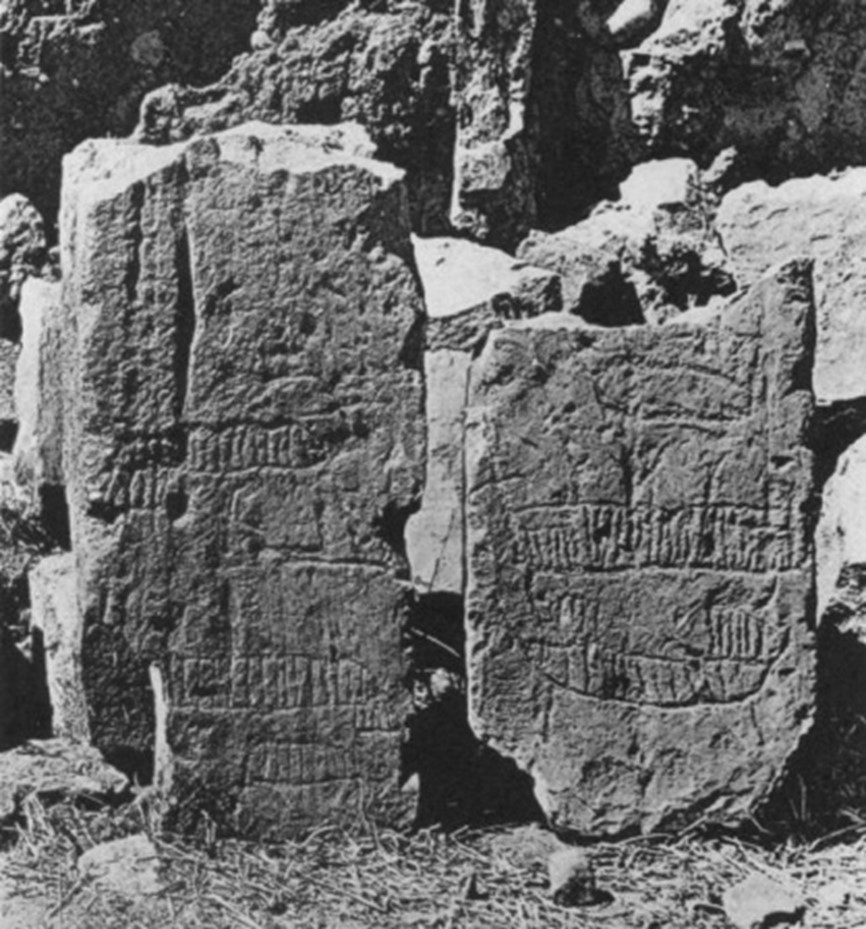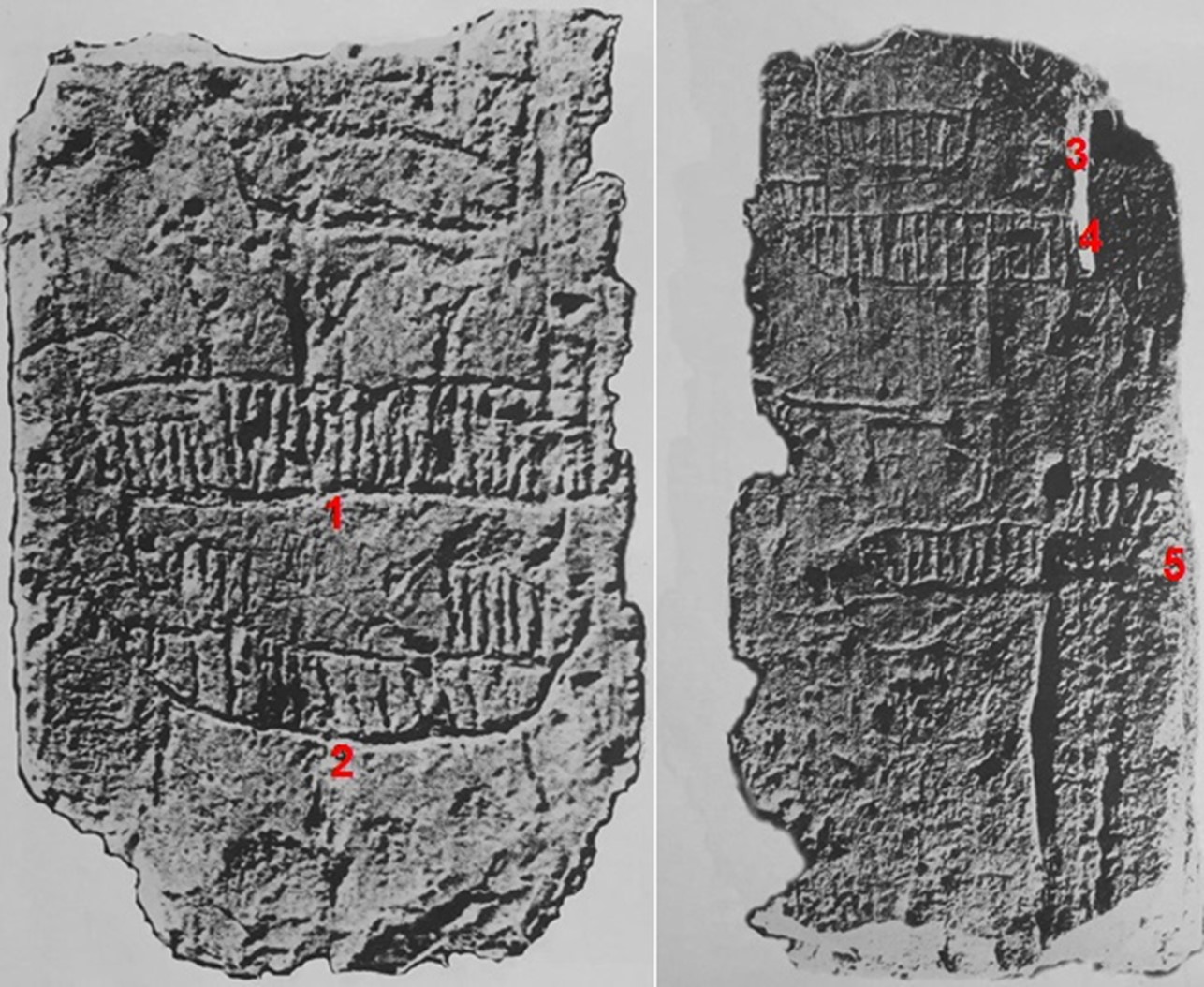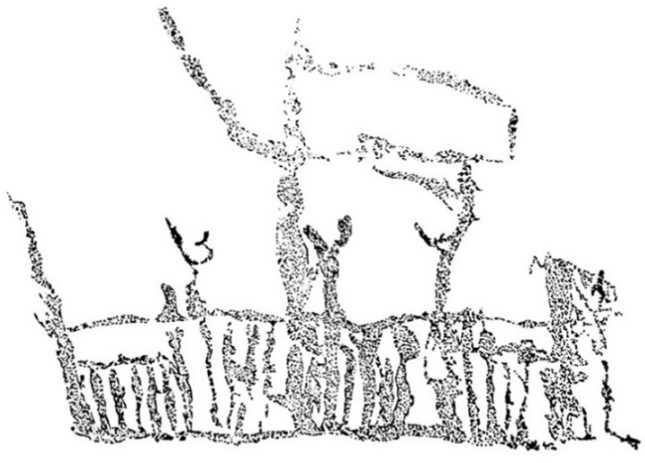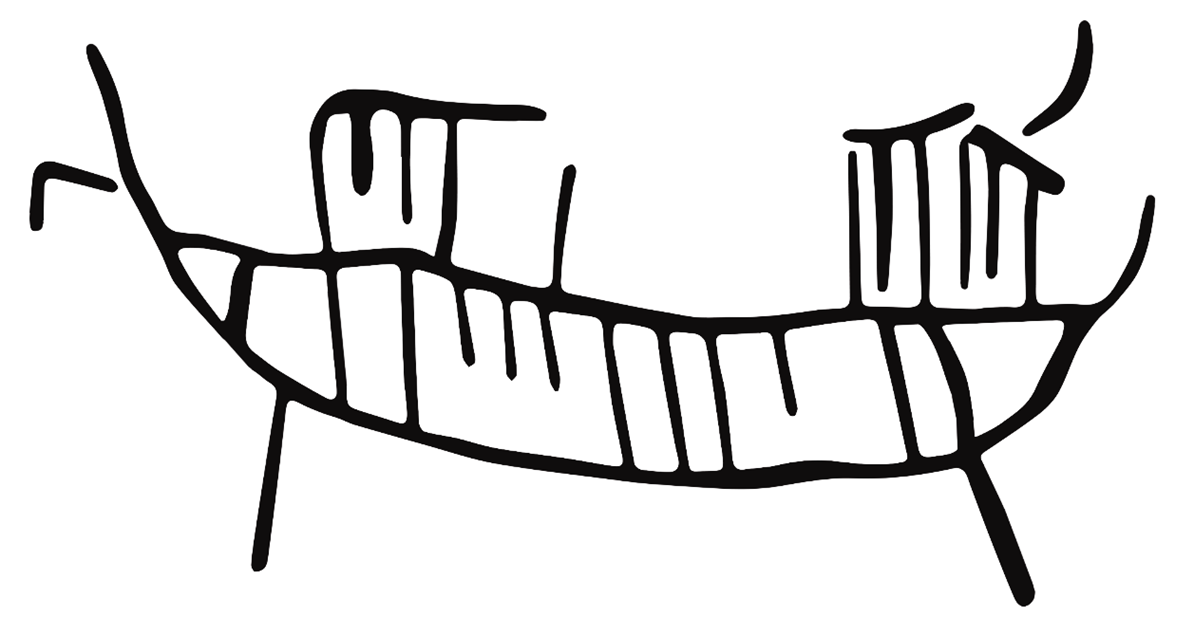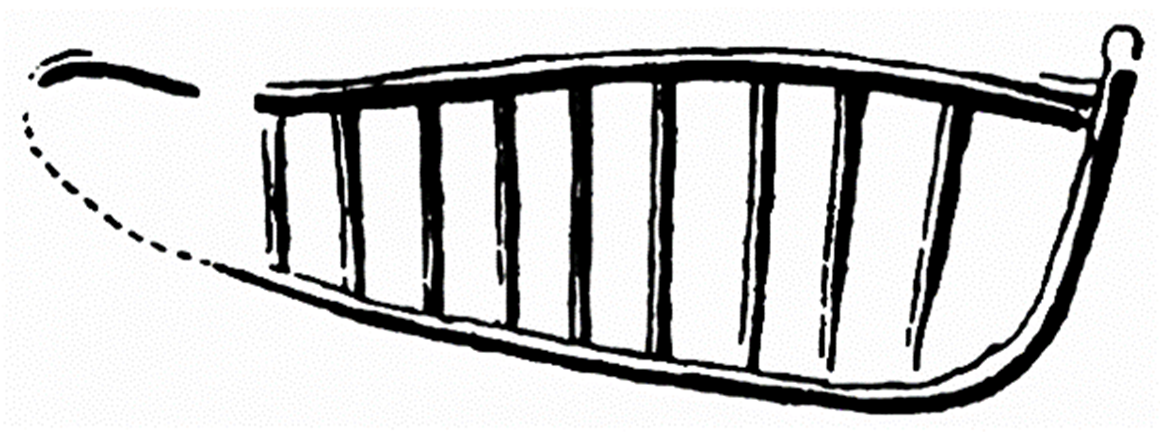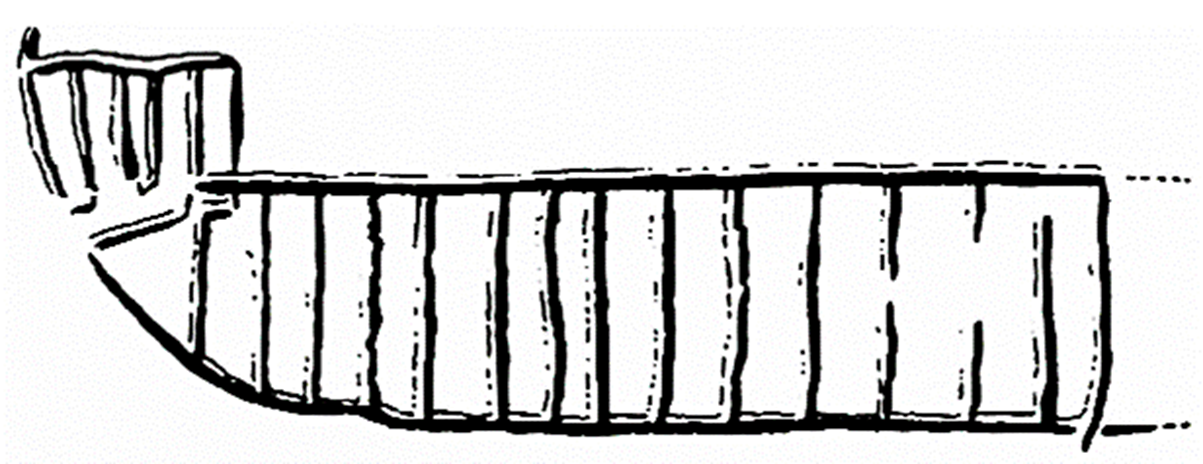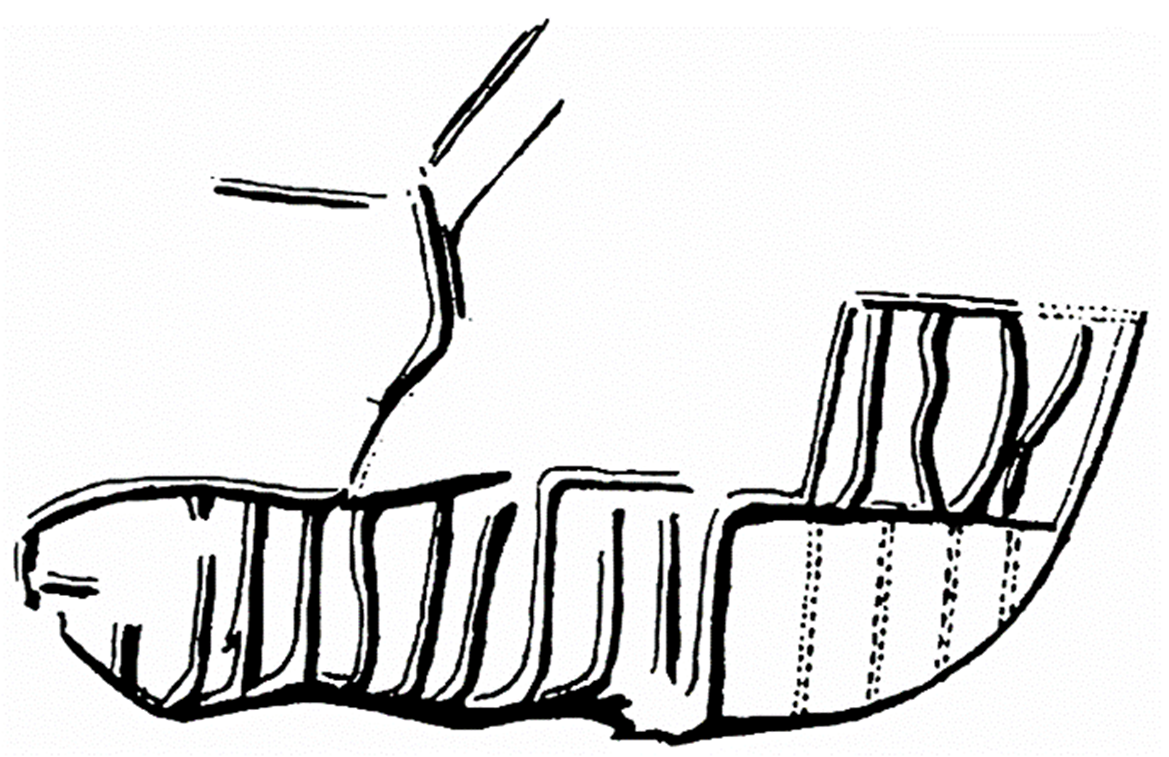All of the vessels share in common the use of
what Wachsmann has coined the horizontal ladder motif in Aegean ship
iconography. While details such as the presence of castles, oars or
rigging vary, they all share this core structure comprised of two
horizontals joined together by a series of parallel vertical lines. In
the most simplified examples, this is the only element represented, as
is the case for ship 5. The implication is that the ships must be
galleys, but Wachsmann's argument does not work for A39b which is
clearly very different morphologically, with a distinctly crescentic
hull. On ship A39a furthermore the vertical lines a spaced together very
tightly so that their reading as ribs is far more likely. Such a reading
is in line with Basch's suggestion that the ships are represented using
the x-ray approach.
A44a: Ship to the right with a flat hull, a straight vertical
stempost and a slightly angled straight sternpost, giving the hull a
rectangular appearance. Very short bow projection extending as a direct
continuation of the keel line. The stempost ends in an animal-headed
device carved deep into the rock. There is a single horizontal line
above the keel line representing the gunwale, with the two joined by
23-25 vertical stanchions, creating about 22 "rooms" if interpreted as
an open rowers' gallery. This suggests that a penteconter was probably
intended. However given how tightly spaced they are, it is also possible
that the verticals represent ribs. The stanchions are shortened at the
bow and stern to make room for a reserved horizontal rectangle placed
over them. These do not rise above the gunwale and must represent the
fore- and aftercastle. The mast is amidships, with a rectangular sail
billowing to the right, and an oblique line extending from the left
side. Wachsmann notes that there is a line extending below the hull at
the stern which is not included in the original drawing but is clearly
visible on the photograph. It is angled towards the bow and is likely
the steering oar. There are three Y-shaped vertical poles extending
above the hull, two fore and one aft. Basch interprets these as
stanchions with lunate tops to support the rig when it is lowered, but
Wachsmann suggests they might be schematic depictions of humans, which
would be more in line with Helladic ship imagery. This is the most
complex depiction out of the five graffiti.
A44b: Crescent shaped keel line connected to the gunwale by 12
vertical parallel lines (ribs), with the keel's curve slightly steeper
on the right side. Extending below the hull at each end there is an
oblique line, the left one being nearly vertical. At both extremities
atop the gunwale are square constructions filled with more vertical
parallel lines. There is an L-shaped hook facing downwards extending
from the post on the left side, and an oblique line above the
construction on the right. It is difficult to determine the direction of
the ship, since the presence of what would normally be interpreted as a
steering oar on each end makes the reading problematic. The curvature on
both ends is also quite similar. Wachsmann interprets the left side as
the sternpost but no justification is given. Basch considers the two
constructions to be a fore- and aftercastle, while Morgan reads them as
cabins. This graffito appears to be a rare late depiction of the Minoan
Type IV vessel, as evidenced by the shape of the hull and the
superstructure elements (Wedde 2000: 53). It is tempting to read at least one of
these deck structures as an ikrion, but the representation is too
schematic to provide certainty.
A44c: The ship is reduced to the horizontal motif alone, with the
two horizontals representing the keel line and the gunwale joined by
nine vertical stanchions. The hull is flat, with the two horizontals
converging to a narrower point on the left extremity. On the right side,
the post is slightly angled and straight. It is difficult to tell in
which direction the ship is facing. This is the simplest representation
of the group.
A44d: Horizontal ladder motif, with the two horizontals representing
the keel line and the gunwale joined by 15 vertical stanchions. The hull
is completely flat. The right extremity is likely missing, while the
left extremity curves gradually and is topped by a castle represented by
a shorter ladder motif filled with four vertical lines. The left end
probably represents the stern with an aftercastle.
A44e: Ship facing left (?), made up of the horizontal ladder motif,
with the two horizontals representing the keel line and the gunwale
joined by 15 vertical stanchions. Flat hull, with gradually curving
extremities. the left extremity curves gradually and is topped by a
castle represented by a shorter ladder motif with four vertical lines.
The right end is probably the stern with an aftercastle represented by a
shorter ladder motif filled with four vertical lines. Both the curvature
of the sternpost and the shape of the aftercastle are identical to those
of ship 4. Amidships is a single bent Y-shaped pole.
Five ship graffiti
A44a-e
LH IIIB (?)
Dramesi, near tholos tomb (Boeotia, near Aulis), Homeric Hyria
H: 1.46 m; W: 0.43 m; thickness: 0.54 m
Rectangular rock pillar or anta broken in two parts. One half is missing
Skhimatari Museum
Basch 1987: 143-44, nos. 300-302; Blegen 1949; Buchholz and Karageorghis 1973: 94, nr 1168; Le Bon 1997: 131-37, fig. 8.10; Wedde 2000: 328-29, nos. 683-689; Wachsmann 1998: 143-47, figs. 7.30, 7.31
Found near a tholos tomb dated to the end of the Middle Helladic/beginning of Late Helladic period. The tomb contained pottery and fragments of bronze weapons, including a javelin point/spearhead. As the pillar was recovered from amongst the stones that were assembled for removal by illicit excavators, its relationship to the burial remains uncertain as there is no secure association. The similarities to the Tragana ship rule against assigning the graffiti as contemporaneous with the tomb assemblage. A late date as suggested by Buchholz and Karageorghis is to be preferred (Buchholz and Karageorghis 1971: 94; Wedde 2000: 55). One of the pillar's faces is badly damaged, while the other three have remains of shallow carvings. The photographed graffiti that include five ships are thought to belong to the front of the pillar which is broken in two parts, one of which is now missing. Blegen reports that the left side which was in a worse condition retained traces of at least two more ships but these were never illustrated. The right side is reported to have had some incisions as well, although even less clearly recognizable - possibly another ship. The graffiti appear to be the product of a single event, as they express both stylistic and compositional coherence.
Basch, L. 1987. Le musée imaginaire de la marine antique. Athens: Institut Hellénique pour la preservation de la tradition nautique.
Blegen, C. W. 1949. “Hyria,” in Commemorative Studies in Honor of Theodore Leslie Shear. Hesperia Suppl. VIII: 39-42.
Buchholz, H.-G. and V. Karageorghis. 1973. Prehistoric Greece and Cyprus: An Archaeological Handbook. London: Phaidon.
Karageorghis, V. 1973-74. Salamis V. Excavations in the Necropolis of Salamis. Vol. III. Nicosia: Department of Antiquities, Cyprus.
Le Bon, E. 1997. “Images out of Water: Aspects of the Interpretation of Ancient Maritime Grafitti.” PhD Thesis, University of St. Andrews, UK.
Wachsmann, S. 1998. Seagoing Ships & Seamanship in the Bronze Age Levant. College Station, TX: Texas A&M University Press.
Wedde, M. 2000. Towards a Hermeneutics of Aegean Bronze Age Ship Imagery. Peleus Studien zur Archäologie und Geschichte Griechenlands und Zyperns, vol. 6. Bibliopolis: Mannheim and Möhnsee.


